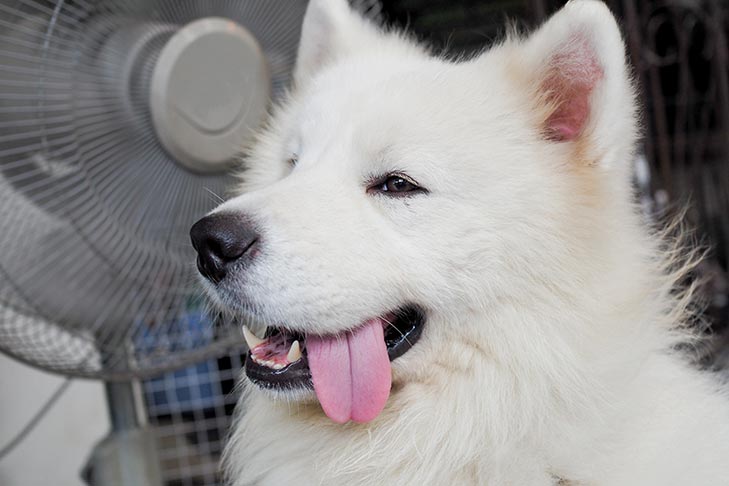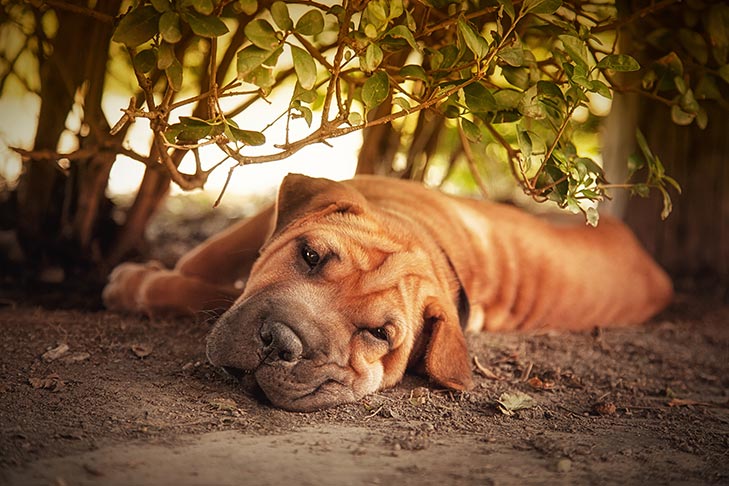Have you ever noticed that your dog’s mood shifts with the weather? Storms, heat, cold, and the changing seasons affect our dogs, just like they affect us. Understanding this behavior can help you prepare your canine companion for the forecast ahead.
Changing Seasons
When the temperature heats up, some dogs rejoice, while others seek out cool, shady spots where they can rest. Though all dogs can be susceptible to hot weather hazards, certain dog breeds are less heat tolerant than others. Brachycephalic breeds, such as Bulldogs, French Bulldogs, Pugs, and Boston Terriers, do best when staying cool in hot weather because they can have difficulty breathing in extreme heat. Large breeds are also susceptible to heat, as are longhaired breeds like the Komondor, Afghan Hound, and Alaskan Malamute. If you own a breed like these, you may find that your dog is not as active in hot weather or as willing to engage in play and other activities.
Colder climates, on the other hand, is where Northern breeds like American Eskimo Dogs, Samoyeds, and Siberian Huskies thrive. Longhaired or double-coated breeds like German Shepherd Dogs, Saint Bernards, Great Pyrenees, and Newfoundlands typically enjoy cooler weather, too. They often become more active and playful during the winter months, unlike cold-intolerant breeds such as Italian Greyhounds, Greyhounds, hairless breeds, toy breeds, senior dogs, and dogs with conditions such as hypothyroidism or Cushing’s disease.
Relocating to a New Climate
Seasons change gradually, giving your dog time to adjust. Relocating to an entirely new climate, however, can cause sudden shifts in your pup’s mood. Depending on your dog’s breed, you may notice that he becomes more or less active, and some dogs even show signs of irritation if the weather makes them too uncomfortable.
A move to a cold climate can be shocking for dogs that are not used to chilly temperatures. Some pups seek out warm places, like air vents, blankets, or human contact, and you might notice your canine companion becoming cuddlier in the cold. Understanding the cause of your dog’s sudden lethargy or increased activity can help you determine if his change in mood is circumstantial or medical. Lethargy is a common symptom of many illnesses and should be taken seriously, so make sure your dog is not exhibiting any other abnormal signs. If he is, consult your veterinarian immediately.
Helping Your Dog Adjust
If your dog gets grumpy in the heat, don’t worry. There are things you can do to make him more comfortable and lower his risk of heatstroke.
- Avoid taking your dog for walks during the hottest parts of the day.
- Make sure he has plenty of fresh water.
- Raised canvas platform dog beds offer a cooling alternative to traditional beds, and you can even invest in cooling mats or kiddie pools for particularly heat-intolerant dogs.
- If you don’t have air conditioning, adjust a fan so that your dog has access to a nice, cool breeze.
- Never leave a dog unattended in an enclosed vehicle or in a warm environment that does not have good air circulation.
You can also help your dog acclimate to the cold. After all, who doesn’t love a pup in a sweater? With so many dog sweaters, jackets, raincoats, and booties to choose from, keeping your dog warm is easier than ever. However, it’s important to note that you should never leave an item of clothing on an unsupervised dog. And anything you do put on your canine companion should fit properly (not too tight or too loose).
Recent Pet Posts
Blog Categories
Product categories
- Accessories (7)
- Chicken & Veggie Wraps (8)
- Grillers Jerky Tenders (4)
- Jerky Treats (10)
- Made in the USA (9)
- Non-Rawhide Treats (28)
- Beggar Bone (11)
- Bully Sticks (4)
- Butcher Bone (4)
- Cod Skin Fish Treats (3)
- Pork Skin Twists (2)
- Pressed Rawhide Bones & Rolls (16)
- Bones & Rolls (6)
- Pressed Rawhide Bulk (6)
- Twist Sticks (4)
- Savory Munchies (13)
- Supreme Bones & Rolls (48)
- American Rawhide Bulk (16)
- Rawhide Bones (14)
- Rawhide Chips (6)
- Rawhide Rolls & Sticks (12)
- Uncategorized (8)



